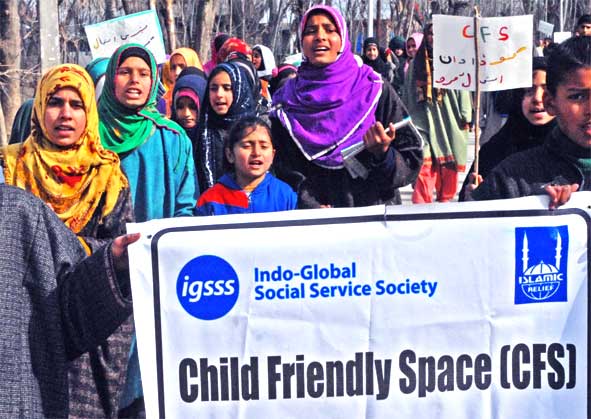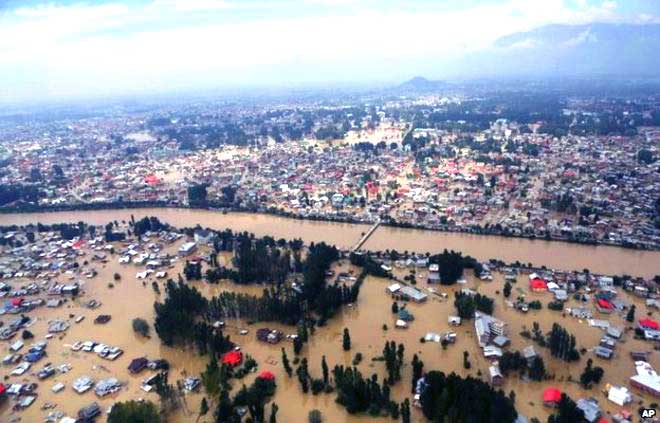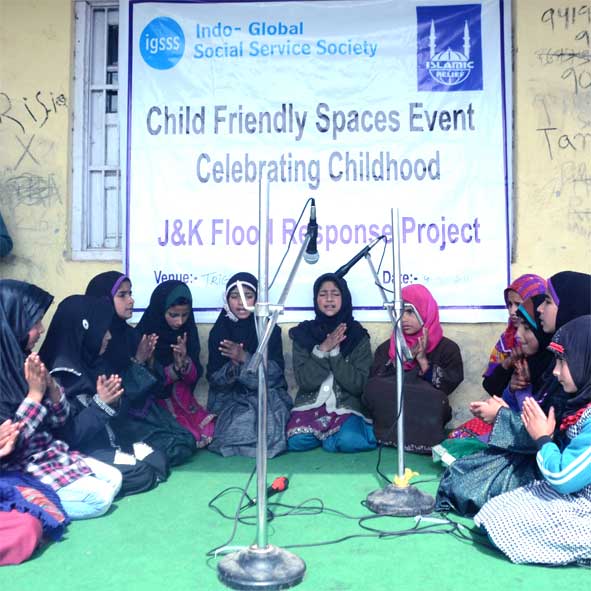
 Out of Chaos, Child Friendly Spaces Emerged as Sunshine for Rural Children in Flood-Ravaged Kashmir
Out of Chaos, Child Friendly Spaces Emerged as Sunshine for Rural Children in Flood-Ravaged Kashmir
By SUMERA B. RESHI
Mother Nature showed its fury on the 7th September 2014 when incessant rains lashed Kashmir and washed everything whatever came its way. River Jhelum’s waves became too turbulent to be controlled by just cosmetic measures. Jhelum waters breeched every limit and drenched the entire city into a cesspool. People of the state of Jammu & Kashmir felt completely helpless and in utter chaos. They screamed for help, but nobody came to their rescue. The state of Jammu & Kashmir went into a state of anarchy and the people had little or no access to rescue measures or to basic amenities of life. Government’s response to this catastrophe was minuscule and came in the form of ‘too late and too little’.
Once the flood waters receded, people tried to get their lives on track but since the devastation was so colossal it will take years to get things back on track properly. According to a report released by the state government, the floods have caused huge damage to the lives and property. The government estimate of the damage caused by the floods is:
- 1,250,000 families affected
- 5,642 villages affected in State
- 800 villages remained sub-merged for over two weeks
- 281 lives lost
Similarly, KashmirUzma, a local newspaper, reported last month that according to an estimation of the World Bank, the damage caused by the devastation stood around 211.1975 Billion rupees.
Nothing was in sight other than the debris and schools were not an exception. Obviously, thousands of families in flood-affected areas of Kashmir went into deep crisis and in such a chaotic situation, children suffered the most, reported Greater Kashmir, a local English daily, in October 2014.
In addition, the three decades of conflict in the region has confined children from having their free space where they could grow freely with nature. The conflict has given rise to rampant corruption and in the midst of all this chaos; educational sector has suffered very badly. Many claim that the education system in Kashmir is not supportive and does not allow any freedom of expression. It is as choked as democracy itself in this region, ravaged by the longstanding conflict. The situation is alarming in rural areas where infrastructure is in shambles and no separate space or facilities are in sight for children to spend time in.

- Child Friendly Spaces not only allow children to learn and play, but also serve as a medium for them to connect with their culture and history.
- The CFS is a structured and safe place where children and youth meet other children to play, learn competencies and skills to deal with the risks they face, be involved in some educational activities and relax in a safe place.
Moreover, the lives of rural children are quite different than that of their counterparts in urban areas. In rural areas, children are accountable for their role in domestic chores, in addition to academic performances. They shoulder a double burden. They, thus, find themselves shuttling between academic and domestic expectations. In such a scenario, these rural children virtually lose their childhood; they don’t have time for recreation or entertainment. They play with whatever they find around, not considering hygiene or the safety. Children in rural areas lack basic facilities like parks or other means of recreation, so they feel left out.
Furthermore, recent floods have added misery to people since they washed away the basic infrastructure like houses and schools. A survey conducted by Roads and Building (R&B) after the devastating floods revealed that all school buildings including other infrastructures was unsafe for human use. These findings are applicable to the worst hit areas of Bandipora and Baramulla districts. The floods have disturbed the lives of the children in particular. Left homeless by the disaster, many of them had to clear the debris and earn for their families. In this race of survival, children in rural areas forgot they were once enrolled in schools.
See Also:
Space for Growth
For overall growth, these children needed to live their childhood fully in sync with the nature. They needed a space to discover themselves. They thus needed spaces within the community where they could come together freely and engage in creative exercises to vent their feelings and to rebuild their lives. Thus, an NGO called Indo-Global Social Service Society set up child friendly spaces (CFS) in Baramulla and Bandipors districts. The cardinal aim of CFS is to cater to the psychological, recreational and even educational needs of rural children. This concept was unheard of in Kashmir previously.

So what is this CFS? The CFS is a structured and safe place where children and youth meet other children to play, learn competencies and skills to deal with the risks they face, be involved in some educational activities and relax in a safe place. It gives the children the sense of safety, structure and continuity that provides support in the aftermath of natural disasters like floods in Kashmir. It gives them a sense of belongingness after having been displaced and living in tents and camps. It builds cohesion and a sense of community.
After any natural disaster, there is certainly a need to bring the affected population back to normal life. In such a case, the CFS provides the mechanisms for bringing children and young people back to normal routines. The following elements comprise the mechanisms for establishing normalcy:
- Psychosocial Support: Psychosocial support is provided through sensitized staff; establishment of routines; through an opportunity for personal space and belongings; the children having the surety that the CFS is safe; emotional and physical comfort and reduction in stress.
- Child Protection Center: A space where young children in the age-group 3-5 years come in the morning for four hours to play and learn. Young volunteers from the community/camp work with these children, teaching those nursery rhymes, drawing and other skills to build their motor abilities. Though, Child protection Center is not a priority in Kashmir.
These centers concentrate only on psychological aspects. Today these CFSs serve as alternative spaces within villages for children to come together and engage in activities that allow both recreation and information. The CFSs allow the children from disadvantaged sections of the society to have an equal access to recreation and information. The centers also act as information zones to help prevent child abuse where the volunteers make children aware about child abuse and its prevention. These CFSs are aimed at taking the children out of the classrooms and giving them a safe environment to learn on their own while also exploring their creative tastes. Also in absence of the usability of counseling as a method of psychological intervention for the children affected by floods, it becomes imperative to explore other methods of catharsis, in which these centers prove to be helpful.CFSs play an important role in identifying children that need special protection,
The CFS centers are proving to be increasingly popular among the children who find it interesting to visit a place that allows them to learn and play at the same time. Masarat, a 2nd class student exclaims, “I like to attend the center as I can play with my friends and learn too. There is no force on anything and I can be myself”.
Child Friendly Spaces not only allow children to learn and play, but also serve as a medium for them to connect with their culture and history.
A visit to a CFS in Trigam in Bandipora had a scene of children listening to a story about Habba Khatoon, a leading poetess of the Valley with great excitement. Paintings created by young hands adorn the walls of the CFS and the children cherish their color boxes more than anything.
The volunteers often admit that the enthusiasm of the children forces them to keep the center open even during holidays. This claim is corroborated by the fact that children run after the CFS volunteer in Gund Nowgam. The centers are also aimed at being centers for dissemination of information regarding child abuse, child rights and hygiene practices. These hygiene drives are often conducted randomly at regular intervals by the village volunteers as well.
The popularity of the centers is such that there are children who are not enrolled in the centers, but often come to the center lured by the charm of playing with things that have been denied to them by circumstances. In such conditions the children are allowed to attend and to play and learn. The Child Friendly Centers are places where children can vent their feelings unlike their adult counterparts for whom speaking often is the best way of de-stressing. Given the post-floods traumas, the centers form a warm and protective environment for the children to express themselves, to learn and to grow in the company of other young blossoms. Thanks to the devastating floods because they paved way for something ‘out of box’ in Kashmir.
(Sumera is Global South Development Magazine’s Development Reporter based in Kashmir, India.)











